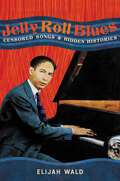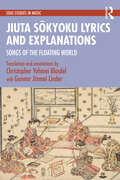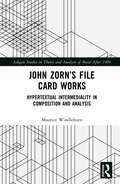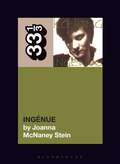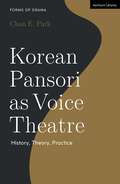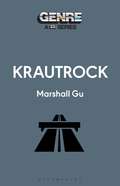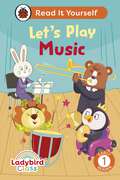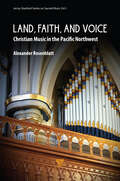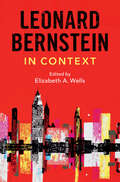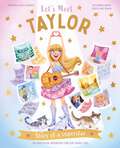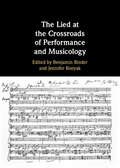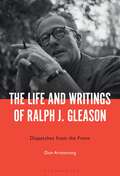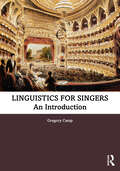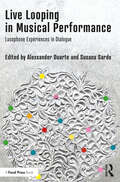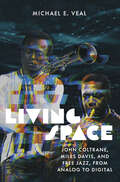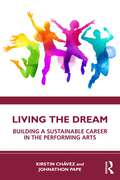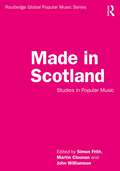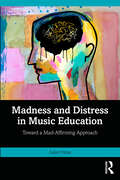- Table View
- List View
Jelly Roll Blues: Censored Songs and Hidden Histories
by Elijah WaldA bestselling music historian follows Jelly Roll Morton on a journey through the hidden worlds and forbidden songs of early blues and jazz. In Jelly Roll Blues: Censored Songs and Hidden Histories, Elijah Wald takes readers on a journey into the hidden and censored world of early blues and jazz, guided by the legendary New Orleans pianist Jelly Roll Morton. Morton became nationally famous as a composer and bandleader in the 1920s, but got his start twenty years earlier, entertaining customers in the city&’s famous bordellos and singing rough blues in Gulf Coast honky-tonks. He recorded an oral history of that time in 1938, but the most distinctive songs were hidden away for over fifty years, because the language and themes were as wild and raunchy as anything in gangsta rap. Those songs inspired Wald to explore how much other history had been locked away and censored, and this book is the result of that quest. Full of previously unpublished lyrics and stories, it paints a new and surprising picture of the dawn of American popular music, when jazz and blues were still the private, after-hours music of the Black "sporting world." It gives new insight into familiar figures like Buddy Bolden and Louis Armstrong, and introduces forgotten characters like Ready Money, the New Orleans sex worker and pickpocket who ended up owning one of the largest Black hotels on the West Coast. Revelatory and fascinating, these songs and stories provide an alternate view of Black culture at the turn of the twentieth century, when a new generation was shaping lives their parents could not have imagined and art that transformed popular culture around the world—the birth of a joyous, angry, desperate, loving, and ferociously funny tradition that resurfaced in hip-hop and continues to inspire young artists in a new millennium.
Jiuta Sōkyoku Lyrics and Explanations: Songs of the Floating World (ISSN)
Jiuta Sōkyoku Lyrics and Explanations is a compendium of seventy-three representative songs from the well-known genre of traditional Japanese Edo-period sankyoku ensemble music.Including extensive annotations along with commentaries and notes on their musical and performative aspects, the collection begins with an overview which traces the history of the jiuta sōkyoku genre and the various socio-political influences at work in its formation. The translations and analyses are followed by a substantive glossary and bibliography, allowing for a deeper understanding of both the literary and musical aspects of jiuta sōkyoku compositions.Jiuta Sōkyoku Lyrics and Explanations is a comprehensive anthology that will be of great interest to researchers, including ethnomusicologists, Japanese studies scholars and poetry lovers who are fascinated with the literary and musical impact of the Edo period.
Jiuta Sōkyoku Lyrics and Explanations: Songs of the Floating World (ISSN)
by Christopher Yohmei Blasdel Gunnar Jinmei LinderJiuta Sōkyoku Lyrics and Explanations is a compendium of seventy-three representative songs from the well-known genre of traditional Japanese Edo-period sankyoku ensemble music.Including extensive annotations along with commentaries and notes on their musical and performative aspects, the collection begins with an overview which traces the history of the jiuta sōkyoku genre and the various socio-political influences at work in its formation. The translations and analyses are followed by a substantive glossary and bibliography, allowing for a deeper understanding of both the literary and musical aspects of jiuta sōkyoku compositions.Jiuta Sōkyoku Lyrics and Explanations is a comprehensive anthology that will be of great interest to researchers, including ethnomusicologists, Japanese studies scholars and poetry lovers who are fascinated with the literary and musical impact of the Edo period.
John Zorn’s File Card Works: Hypertextual Intermediality in Composition and Analysis (ISSN)
by Maurice WindleburnThis book is the first study of John Zorn’s ‘file card’ works, with special focus made on the pieces Godard (1985), Spillane (1986), Interzone (2010), and Liber Novus (2010). It explains the unique creative process behind these compositions, contextualizing them in relation to the history of file cards, the ‘open work’ concept, cinematic listening, and uncreative aesthetics. Semiotic, hermeneutic, and ekphrastic analyses draw hypertextual links between the four file card compositions and the worlds of their respective dedicatees: author Mickey Spillane, filmmaker Jean-Luc Godard, novelist William S. Burroughs and painter Brion Gysin, and psychiatrist C. G. Jung.This book will appeal not only to those interested in Zorn’s music, but also to scholars of music semiotics and hermeneutics, intermedia studies, and avant-garde music.
John Zorn’s File Card Works: Hypertextual Intermediality in Composition and Analysis (ISSN)
by Maurice WindleburnThis book is the first study of John Zorn’s ‘file card’ works, with special focus made on the pieces Godard (1985), Spillane (1986), Interzone (2010), and Liber Novus (2010). It explains the unique creative process behind these compositions, contextualizing them in relation to the history of file cards, the ‘open work’ concept, cinematic listening, and uncreative aesthetics. Semiotic, hermeneutic, and ekphrastic analyses draw hypertextual links between the four file card compositions and the worlds of their respective dedicatees: author Mickey Spillane, filmmaker Jean-Luc Godard, novelist William S. Burroughs and painter Brion Gysin, and psychiatrist C. G. Jung.This book will appeal not only to those interested in Zorn’s music, but also to scholars of music semiotics and hermeneutics, intermedia studies, and avant-garde music.
k.d. lang's Ingénue (33 1/3)
by Joanna McNaney SteinCanadian performer k.d. lang broke new ground in the 1980s by blending the genres of punk and country, dubbed “cowpunk,” with her band, the Reclines. Despite Grammy-award-winning recordings and frequent North American TV spots, mainstream country radio excluded lang from airplay due to her unconventional gender presentation and perceived sexuality. Not until lang's 1992 pop album Ingénue, the release of the single “Constant Craving,” and her subsequent coming out in The Advocate did lang earn critical acclaim worldwide. The book addresses lang's rise to fame after switching genres, the successful reinvention of her sound and persona, and how she found herself immersed in the whirlwind of MTV and the "lesbian chic" aesthetic of 1990s pop culture. As an LGBTQ author, Joanna McNaney Stein discusses her adolescence and sexual development by weaving in short narrative prose pieces with her analysis of lang and Ingénue. Also included are interviews with lang's musical collaborators: Ingénue co-writer Ben Mink, drummer Fred Eltringham, pianist Daniel Clarke, and singer-songwriter Laura Veirs.
Korean Pansori as Voice Theatre: History, Theory, Practice (Forms of Drama)
by Chan E. ParkThis book introduces readers to the historical, performative, and cultural context of pansori, a traditional Korean oral story-singing art. Written by a scholar-practitioner of the form, this study is structured in three parts and begins by introducing readers to the technical, aesthetic, and theoretical components of pansori, as well as the synthesis of vocal and percussive elements that stage the narrative. It moves on to reflect on the historical contexts of pansori, alongside Korea's transformation from Joseon monarchy to modern statehood. It argues that with colonial annexation came modernist influences that Korean dramatists and audiences used to create new genres of performance, using the common thread of pansori. The book's third part explores the interplay of preservation and innovation, beginning in the post-war period and continuing with developments in the 20th and 21st centuries that coincide with Korea's imprint on cultural globalization. Along with Korea's growth as a world economic center, a growing enthusiasm for Korean culture around the world has increased the transmission and visibility of pansori. This study argues that tradition and innovation are not as divergent as they are sometimes imagined to be and that tradition is the force that enables innovation. Drawing on Chan E. Park's ethnographic work and performance practice, this book interweaves expert knowledge of both the textual and performative aspects of pansori, rendering legible this dramatic tradition.
Krautrock (Genre: A 33 1/3 Series)
by Marshall GuKrautrock is not a music genre. Krautrock is a way of life. Its sonic diversity and global reach belie the common culture from where it emerged. This is a band-by-band history. In May 1945, the Allies defeated Nazi Germany, putting an end to the European front of World War II and the Third Reich. In the immediate aftermath, German youth were tasked to create their own culture. Krautrock is this unlikely success story, as hundreds of bands-including Kraftwerk and Can-seemed to sprout overnight in the early 1970s, forging a unique and experimental sound that was different than American or British rock. The major innovation of krautrock is not only its motorik beat, the steady click-click of Can's Jaki Liebezeit or monolithic stomp-stomp of Neu!'s Klaus Dinger, but also how the musicians relate to each other. In krautrock, no musician is given more focus than any other, and listening to these bands is to witness interplay common in jazz music. Thus, krautrock represents German politics reflected in music: a dictatorship replaced by democracy. Krautrock explores the history and methodology of the genre, charting its influences and innovations, its more mainstream acts (like Faust, Kraftwerk, and Can) as well as the less universally known (including Harmonia, Popol Vuh, Embryo, and Ash Ra Tempel), and how the genre developed in post-war Germany and what it means to today's listeners.
Ladybird Class Let's Play Music: Read It Yourself - Level 1 Early Reader (Read It Yourself)
by LadybirdJoin Ladybird Class on another imaginative learning adventure! The class are learning all about musical instruments, and soon find themselves watching an amazing orchestra. But when disaster happens, can Ali Lion step in and save the day?Let's Play Music is from Early Reader Level 1 and is perfect for children aged from 4+ who are taking their first steps beyond phonics.Each book has been carefully checked by educational and subject consultants and includes comprehension puzzles, book band information, and tips for helping children with their reading.With five levels to take children from first phonics to fluent reading and a wide range of different stories and topics for every interest, Read It Yourself helps children build their confidence and begin reading for pleasure.
Land, Faith, and Voice: Christian Music in the Pacific Northwest
by Alexander RosenblattThis book summarizes a decade of research on its topic, while each specific perspective either formed in advance, or arose in the process of ethnography and its analysis. The book explores various aspects of Christian music in British Columbia, Washington State, and Oregon, but primarily its historical facets and local palette. The scope of the main topics covers aspects such as historical and local melodies in relevant hymnbooks, musical practices in the Cathedrals and other churches within the designated area, and the creative profile of modern North American composers (including those who have worked in the Pacific Northwest), who made significant contributions to the church music practiced in the area. Other background and supporting topics are a reference on the history and culture of the Canadian and U.S. parts of the region, the study of Native Christian art, its philosophy and examples, and historical stages and the current landscape of Christianity in British Columbia, Washington State, and Oregon.The book bears the features of a monograph and a handbook at the same time. Among the few other books dealing with specific topics that make up the content of this book, none of them gives an all-around picture of the regional history, society, culture, art, religion, and its musical expression as a holistic phenomenon.
Land, Faith, and Voice: Christian Music in the Pacific Northwest
by Alexander RosenblattThis book summarizes a decade of research on its topic, while each specific perspective either formed in advance, or arose in the process of ethnography and its analysis. The book explores various aspects of Christian music in British Columbia, Washington State, and Oregon, but primarily its historical facets and local palette. The scope of the main topics covers aspects such as historical and local melodies in relevant hymnbooks, musical practices in the Cathedrals and other churches within the designated area, and the creative profile of modern North American composers (including those who have worked in the Pacific Northwest), who made significant contributions to the church music practiced in the area. Other background and supporting topics are a reference on the history and culture of the Canadian and U.S. parts of the region, the study of Native Christian art, its philosophy and examples, and historical stages and the current landscape of Christianity in British Columbia, Washington State, and Oregon.The book bears the features of a monograph and a handbook at the same time. Among the few other books dealing with specific topics that make up the content of this book, none of them gives an all-around picture of the regional history, society, culture, art, religion, and its musical expression as a holistic phenomenon.
Leonard Bernstein in Context (Composers in Context)
by Elizabeth WellsDesigned for students, aficionados of classical music, and historians, this volume offers a wide-ranging, multi-disciplinary and comprehensive view of one of the most important musicians of the twentieth century at his 100th anniversary. Scholars from diverse backgrounds and fields have contributed rich insights into Bernstein's life and work in an approachable style, shedding light on Bernstein's social, professional and ideological contexts including his contemporaries and rivals on Broadway, his artistic collaborations, his celebrity status as a conductor on the international concert circuit, and his involvement in music education via broadcasting. From his early education, through his conducting and composing careers, to his fame as musical and cultural ambassador to the world, this book views Bernstein the man and the artist and provides a fascinating overview of American classical music culture during Bernstein's long career in the public spotlight.
Let's Meet Taylor: Story of a superstar
by Claire Baker Alexandra KokenAre YOU ready to meet Taylor? In this fun and friendly unofficial book, follow gifted singer-songwriter Taylor's inspirational journey from growing up on a Christmas tree farm to superstardom. Discover how she never gave up on her dream, from her earliest performances to the multi-talented and award-winning star she is today, and learn why she believes everyone should have the chance to be who they want to be. There are lots of Taylor Easter eggs hiding throughout the book too – can you find them all?Taylor is a hugely successful and record-breaking singer across many styles and genres, always determined to do things her way and stay in control of her music. Her current Eras tour is set to be the highest grossing tour of all time, greeted so enthusiastically by her devoted fans that they shook the ground as much as an earthquake at her show in Seattle!In this unofficial biography for young fans, filled with gentle text and bright illustrations, this is the perfect book for anyone who wants to share in Taylor's dream and celebrate her phenomenal success.
The Lied at the Crossroads of Performance and Musicology
by Benjamin Binder Jennifer RonyakThere seems to be an essential relationship between the performance and the scholarship of the German Lied. Yet the process by which scholarly inquiry and performative practices mutually benefit one another can appear mysterious and undefined, in part because any dialogue between the two invariably unfolds in relatively informal environments – such as the rehearsal studio, seminar room or conference workshop. Contributions from leading musicologists and prominent Lied performers here build on and deepen these interactions to reconsider topics including Werktreue aesthetics and concert practices; the authority of the composer versus the performer; the value of lesser-known, incomplete, or compositionally modified songs; and the traditions, habits and prejudices of song recitalists regarding issues like transposition, programming and dramatic modes of presentation. The book as a whole reveals the reciprocal relevance of Lied musicology and Lied performance, thereby opening doors to fresh and exciting modes of interpretative artistry and intellectual discovery.
The Life and Writings of Ralph J. Gleason: Dispatches from the Front
by Professor. Don ArmstrongDiscover the enthralling world of Ralph J. Gleason, a pioneering music journalist who expanded the possibilities of the newspaper music column, sparked the San Francisco jazz and rock scenes, and co-founded Rolling Stone magazine. Gleason not only reported on but influenced the trajectory of popular music. He alone chronicled the unparalleled evolution of popular music from the 1930s into the 1970s, and while doing so, interviewed and befriended many trailblazers such as Miles Davis, Dizzy Gillespie, Bob Dylan, and the Beatles. A true iconoclast, he dismantled the barriers between popular and highbrow music, and barriers separating the musical genres. He played a crucial role in shaping postwar music criticism by covering all genres and analyzing music's social, political, and historical meanings. This book uncovers never-before-seen letters, anecdotes, family accounts, and exclusive interviews to reveal one of the most intriguing personalities of the 20th century.
Linguistics for Singers: An Introduction
by Gregory CampLinguistics for Singers: An Introduction is a textbook and manual that provides singers with a foundation in linguistic features of four major singing languages—English, Italian, French, and German—and shows how these features can be used to inform vocal performance and interpretation. Going beyond the basics of lyric diction, a grounding in linguistics enables student musicians to understand language holistically and more fully comprehend the music they are learning. The comparative approach to four common languages allows readers to readily grasp similarities and apply principles across vocal repertoire. Beginning with the sounds of a language and gradually moving up through larger levels of linguistic structure, from words to full texts, the chapters illustrate concepts using real examples from art songs and opera. The clear explanations enable readers new to linguistics to connect these concepts with their own musical practice. Designed for flexible use in courses on language and singing, lyric diction, repertoire studies, and collaborative piano, this book provides a vital resource for singers, vocal instructors, and conductors.
Linguistics for Singers: An Introduction
by Gregory CampLinguistics for Singers: An Introduction is a textbook and manual that provides singers with a foundation in linguistic features of four major singing languages—English, Italian, French, and German—and shows how these features can be used to inform vocal performance and interpretation. Going beyond the basics of lyric diction, a grounding in linguistics enables student musicians to understand language holistically and more fully comprehend the music they are learning. The comparative approach to four common languages allows readers to readily grasp similarities and apply principles across vocal repertoire. Beginning with the sounds of a language and gradually moving up through larger levels of linguistic structure, from words to full texts, the chapters illustrate concepts using real examples from art songs and opera. The clear explanations enable readers new to linguistics to connect these concepts with their own musical practice. Designed for flexible use in courses on language and singing, lyric diction, repertoire studies, and collaborative piano, this book provides a vital resource for singers, vocal instructors, and conductors.
Live Looping in Musical Performance: Lusophone Experiences in Dialogue
by Alexsander Duarte Susana SardoLive Looping in Musical Performance offers a diverse range of interdisciplinary perspectives on the application of live looping technology by lusophone performers and composers. This book explores various aspects, including the aesthetic component, instrumentation, and setup, highlighting the versatility of this technology in music-making. Written by musicians and researchers from Portuguese-speaking countries, this book comprises eleven chapters that delve into various musical contexts, genres, and practices. The novelty of including collaborative texts written alongside non-professional researchers offers the possibility of drawing from real experience to consider how live looping has been changing and "cyborguising" the concept of music, the ritual of the performance, the identity of the musicians, and the public's expectations. Live Looping in Musical Performance provides cutting-edge reading for composers and performers, as well as ethnomusicologists, students, and researchers working in the areas of music production, technology, and performance. This book addresses a broader audience, both academic and non-academic, who are interested in new processes of musical creativity in a post-human world.
Live Looping in Musical Performance: Lusophone Experiences in Dialogue
Live Looping in Musical Performance offers a diverse range of interdisciplinary perspectives on the application of live looping technology by lusophone performers and composers. This book explores various aspects, including the aesthetic component, instrumentation, and setup, highlighting the versatility of this technology in music-making. Written by musicians and researchers from Portuguese-speaking countries, this book comprises eleven chapters that delve into various musical contexts, genres, and practices. The novelty of including collaborative texts written alongside non-professional researchers offers the possibility of drawing from real experience to consider how live looping has been changing and "cyborguising" the concept of music, the ritual of the performance, the identity of the musicians, and the public's expectations. Live Looping in Musical Performance provides cutting-edge reading for composers and performers, as well as ethnomusicologists, students, and researchers working in the areas of music production, technology, and performance. This book addresses a broader audience, both academic and non-academic, who are interested in new processes of musical creativity in a post-human world.
Living Space: John Coltrane, Miles Davis, and Free Jazz, from Analog to Digital (Music / Culture)
by Michael E. VealLiving Space: John Coltrane, Miles Davis, and Free Jazz, from Analog to Digital fuses biography and style history in order to illuminate the music of two jazz icons, while drawing on the discourses of photography and digital architecture to fashion musical insights that may not be available through the traditional language of jazz analysis. The book follows the controversial trajectories of two jazz legends, emerging from the 1959 album Kind of Blue. Coltrane's odyssey through what became known as "free jazz" brought stylistic (r)evolution and chaos in equal measure. Davis's spearheading of "jazz-rock fusion" opened a door through which jazz's ongoing dialogue with the popular tradition could be regenerated, engaging both high and low ideas of creativity, community, and commerce. Includes 42 illustrations.
Living the Dream: Building a Sustainable Career in the Performing Arts
by Kirstin Chávez Johnathon PapeLiving the Dream: Building a Sustainable Career in the Performing Arts offers an accessible guide to understanding one’s arts career as a business. This essential companion to the inner workings of the arts world begins with defining the dream, including how to conceive mission statements, branding and business plans. Part II covers sharing the dream with others through social media, networking, and working with agents or artist managers. Part III offers an overview of the financial aspect, including budgets, taxes, and managing risks. Part IV concludes by discussing the realities of an arts career, including work/life balance, preparing for the future, and managing mental health. This practical and insightful overview is a must‑have companion for aspiring and early career professionals in the performing arts, as well as students on a range of arts courses, including Music Business, Entrepreneurship, and Career Skills classes.
Living the Dream: Building a Sustainable Career in the Performing Arts
by Kirstin Chávez Johnathon PapeLiving the Dream: Building a Sustainable Career in the Performing Arts offers an accessible guide to understanding one’s arts career as a business. This essential companion to the inner workings of the arts world begins with defining the dream, including how to conceive mission statements, branding and business plans. Part II covers sharing the dream with others through social media, networking, and working with agents or artist managers. Part III offers an overview of the financial aspect, including budgets, taxes, and managing risks. Part IV concludes by discussing the realities of an arts career, including work/life balance, preparing for the future, and managing mental health. This practical and insightful overview is a must‑have companion for aspiring and early career professionals in the performing arts, as well as students on a range of arts courses, including Music Business, Entrepreneurship, and Career Skills classes.
Made in Scotland: Studies in Popular Music (Routledge Global Popular Music Series)
Made in Scotland: Studies in Popular Music serves as a comprehensive and thorough introduction to the history, politics, culture, and musicology of twentieth- and twenty-first-century popular music in Scotland. The volume consists of essays by local experts and leading scholars in Scottish music and culture, and covers the major figures, styles, and social contexts of popular music in Scotland. Each essay provides adequate context so readers understand why the figure or genre under discussion is of lasting significance. The book includes a general introduction to Scottish popular music, followed by essays organized into three thematic sections: Histories, Politics and Policies, and Futures and Imaginings. Examining music as cultural expression in a country that is both a nation and a region within a larger state, this volume uses popular music to analyse Scottishness, independence, and diversity and offers new insights into the complexity of cultural identity, the power of historical imagination, and the effects of power structures in music. It is a vital read for scholars and students interested in how popular music interacts with and shapes such issues both within and beyond the borders of Scotland.
Made in Scotland: Studies in Popular Music (Routledge Global Popular Music Series)
by Simon Frith Martin Cloonan John WilliamsonMade in Scotland: Studies in Popular Music serves as a comprehensive and thorough introduction to the history, politics, culture, and musicology of twentieth- and twenty-first-century popular music in Scotland. The volume consists of essays by local experts and leading scholars in Scottish music and culture, and covers the major figures, styles, and social contexts of popular music in Scotland. Each essay provides adequate context so readers understand why the figure or genre under discussion is of lasting significance. The book includes a general introduction to Scottish popular music, followed by essays organized into three thematic sections: Histories, Politics and Policies, and Futures and Imaginings. Examining music as cultural expression in a country that is both a nation and a region within a larger state, this volume uses popular music to analyse Scottishness, independence, and diversity and offers new insights into the complexity of cultural identity, the power of historical imagination, and the effects of power structures in music. It is a vital read for scholars and students interested in how popular music interacts with and shapes such issues both within and beyond the borders of Scotland.
Madness and Distress in Music Education: Toward a Mad-Affirming Approach
by Juliet HessMadness and Distress in Music Education offers an in-depth exploration of mental health and emotional distress in the context of music education, offering new ways of thinking about these experiences and constructing ways to support distress through affirming pedagogy, practices, and policies in music education. Centering the lived experiences of 15 people in a range of roles across music education who self-identify an issue with their mental health, the volume addresses impacts on both students and educators. The author draws on Mad Studies and disability studies to present new paradigms for thinking about Madness and distress in the music context. An essential resource for music educators, music education researchers, and preservice students seeking to understand the complexities of mental health in the music classroom, this book considers how people conceptualize their mental health, how distress impacts participation in music education, how music education may support or exacerbate distress, and what supports for distress can be implemented in music education.
